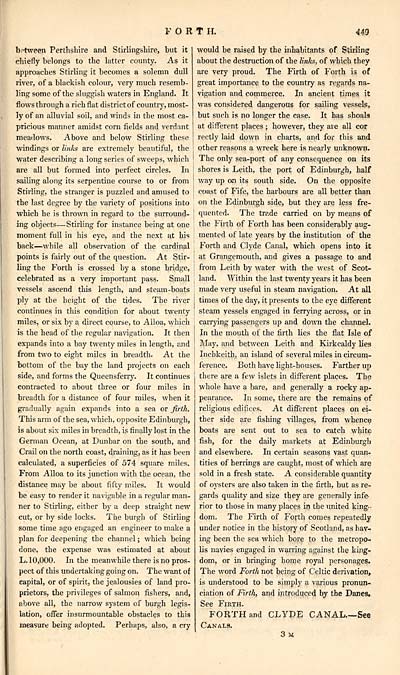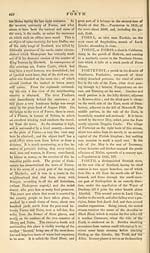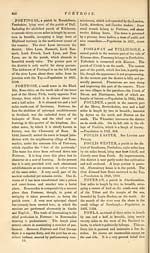Gazetteer of Scotland > Volume 1
(483) Page 449
Download files
Complete book:
Individual page:
Thumbnail gallery: Grid view | List view

FORT H.
449
between Perthshire and Stirlingshire, but it
chiefly belongs to the hitter county. As it
approaches Stirling it becomes a solemn dull
river, of a blackish colour, very much resemb-
ling some of the sluggish waters in England. It
flows through a rich flat district of country, most-
ly of an alluvial soil, and winds in the most ca-
pricious manner amidst corn fields and verdant
meadows. Above and below Stirling these
windings or links are extremely beautiful, the
water describing a long series of sweeps, which
are all but formed into perfect circles. In
sailing along its serpentine course to or from
Stirling, the stranger is puzzled and amused to
the last degree by the variety of positions into
which he is thrown in regard to the surround-
ing objects — Stirling for instance being at one
moment full in his eye, and the next at his
back — while all observation of the cardinal
points is fairly out of the question. At Stir-
ling the Forth is crossed by a stone bridge,
celebrated as a very important pass. Small
vessels ascend this length, and steam-boats
ply at the height of the tides. The river
continues in this condition for about twenty
miles, or six by a direct course, to Alloa, which
is the head of the regular navigation. It then
expands into a bay twenty miles in length, and
from two to eight miles in breadth. At the
bottom of the bay the land projects on each
side, and forms the Queensferry. It continues
contracted to about three or four miles in
breadth for a distance of four miles, when it
gradually again expands into a sea or firth.
This arm of the sea, which, opposite Edinburgh,
is about six miles in breadth, is finally lost in the
German Ocean, at Dunbar on the south, and
Crail on the north coast, draining, as it has been
calculated, a superficies of 574 square miles.
From Alloa to its junction with the ocean, the
distance may be about fifty miles. It would
be easy to render it navigable in a regular man-
ner to Stirling, either by a deep straight new
cut, or by side locks. The burgh of Stirling
some time ago engaged an engineer to make a
plan for deepening the channel ; which being
done, the expense was estimated at about
L. 10,000. In the meanwhile there is no pros-
pect of this undertaking going on. The want of
capital, or of spirit, the jealousies of land pro-
prietors, the privileges of salmon fishers, and,
above all, the narrow system of burgh legis-
lation, offer insurmountable obstacles to this
measure being adopted. Perhaps, also, a cry
would be raised by the inhabitants of Stirling
about the destruction of the links, of which they
are very proud. The Firth of Forth is of
great importance to the country as regards na-
vigation and commerce. In ancient times it
was considered dangerous for sailing vessels,
but such is no longer the case. It has shoals
at different places ; however, they are all cor
rectly laid down in charts, and for this and
other reasons a wreck here is nearly unknown.
The only sea-port of any consequence on its
shores is Leith, the port of Edinburgh, half
way up on its south side. On the opposite
coast of Fife, the harbours are all better than
on the Edinburgh side, but they are less fre-
quented. The trade carried on by means of
the Firth of Forth has been considerably aug-
mented of late years by the institution of the
Forth and Clyde Canal, which opens into it
at Grangemouth, and gives a passage to and
from Leith by water with the west of Scot-
land. Within the last twenty years it has been
made very useful in steam navigation. At all
times of the day, it presents to the eye different
steam vessels engaged in ferrying across, or in
carrying passengers up and down the channel.
In the mouth of the firth lies the flat Isle of
May, and between Leith and Kirkcaldy lies
Incbkeith, an island of several miles in circum-
ference. Both have light-houses. Farther up
there are a few islets in different places. The
whole have a bare, and generally a rocky ap-
pearance. In some, there are the remains of
religious edifices. At different places on ei-
ther side are fishing villages, from whence
boats are sent out to sea to catch white-
fish, for the daily markets at Edinburgh
and elsewhere. In certain seasons vast quan-
tities of herrings are caught, most of which are
sold in a fresh state. A considerable quantity
of oysters are also taken in the firth, but as re-
gards quality and size they are generally infe-
rior to those in many places in the united king-
dom. The Firth of Forth comes repeatedly
under notice in the history of Scotland, as hav-
ing been the sea which bore to the metropo-
lis navies engaged in warring against the king-
dom, or in bringing home royal personages.
The word Forth not being of Celtic derivation,
is understood to be simply a various pronun-
ciation of Firth, and introduced by the Danes.
See Firth.
FORTH and CLYDE CANAL See
Canals.
3 M
449
between Perthshire and Stirlingshire, but it
chiefly belongs to the hitter county. As it
approaches Stirling it becomes a solemn dull
river, of a blackish colour, very much resemb-
ling some of the sluggish waters in England. It
flows through a rich flat district of country, most-
ly of an alluvial soil, and winds in the most ca-
pricious manner amidst corn fields and verdant
meadows. Above and below Stirling these
windings or links are extremely beautiful, the
water describing a long series of sweeps, which
are all but formed into perfect circles. In
sailing along its serpentine course to or from
Stirling, the stranger is puzzled and amused to
the last degree by the variety of positions into
which he is thrown in regard to the surround-
ing objects — Stirling for instance being at one
moment full in his eye, and the next at his
back — while all observation of the cardinal
points is fairly out of the question. At Stir-
ling the Forth is crossed by a stone bridge,
celebrated as a very important pass. Small
vessels ascend this length, and steam-boats
ply at the height of the tides. The river
continues in this condition for about twenty
miles, or six by a direct course, to Alloa, which
is the head of the regular navigation. It then
expands into a bay twenty miles in length, and
from two to eight miles in breadth. At the
bottom of the bay the land projects on each
side, and forms the Queensferry. It continues
contracted to about three or four miles in
breadth for a distance of four miles, when it
gradually again expands into a sea or firth.
This arm of the sea, which, opposite Edinburgh,
is about six miles in breadth, is finally lost in the
German Ocean, at Dunbar on the south, and
Crail on the north coast, draining, as it has been
calculated, a superficies of 574 square miles.
From Alloa to its junction with the ocean, the
distance may be about fifty miles. It would
be easy to render it navigable in a regular man-
ner to Stirling, either by a deep straight new
cut, or by side locks. The burgh of Stirling
some time ago engaged an engineer to make a
plan for deepening the channel ; which being
done, the expense was estimated at about
L. 10,000. In the meanwhile there is no pros-
pect of this undertaking going on. The want of
capital, or of spirit, the jealousies of land pro-
prietors, the privileges of salmon fishers, and,
above all, the narrow system of burgh legis-
lation, offer insurmountable obstacles to this
measure being adopted. Perhaps, also, a cry
would be raised by the inhabitants of Stirling
about the destruction of the links, of which they
are very proud. The Firth of Forth is of
great importance to the country as regards na-
vigation and commerce. In ancient times it
was considered dangerous for sailing vessels,
but such is no longer the case. It has shoals
at different places ; however, they are all cor
rectly laid down in charts, and for this and
other reasons a wreck here is nearly unknown.
The only sea-port of any consequence on its
shores is Leith, the port of Edinburgh, half
way up on its south side. On the opposite
coast of Fife, the harbours are all better than
on the Edinburgh side, but they are less fre-
quented. The trade carried on by means of
the Firth of Forth has been considerably aug-
mented of late years by the institution of the
Forth and Clyde Canal, which opens into it
at Grangemouth, and gives a passage to and
from Leith by water with the west of Scot-
land. Within the last twenty years it has been
made very useful in steam navigation. At all
times of the day, it presents to the eye different
steam vessels engaged in ferrying across, or in
carrying passengers up and down the channel.
In the mouth of the firth lies the flat Isle of
May, and between Leith and Kirkcaldy lies
Incbkeith, an island of several miles in circum-
ference. Both have light-houses. Farther up
there are a few islets in different places. The
whole have a bare, and generally a rocky ap-
pearance. In some, there are the remains of
religious edifices. At different places on ei-
ther side are fishing villages, from whence
boats are sent out to sea to catch white-
fish, for the daily markets at Edinburgh
and elsewhere. In certain seasons vast quan-
tities of herrings are caught, most of which are
sold in a fresh state. A considerable quantity
of oysters are also taken in the firth, but as re-
gards quality and size they are generally infe-
rior to those in many places in the united king-
dom. The Firth of Forth comes repeatedly
under notice in the history of Scotland, as hav-
ing been the sea which bore to the metropo-
lis navies engaged in warring against the king-
dom, or in bringing home royal personages.
The word Forth not being of Celtic derivation,
is understood to be simply a various pronun-
ciation of Firth, and introduced by the Danes.
See Firth.
FORTH and CLYDE CANAL See
Canals.
3 M
Set display mode to: Large image | Transcription
Images and transcriptions on this page, including medium image downloads, may be used under the Creative Commons Attribution 4.0 International Licence unless otherwise stated. ![]()
| Gazetteers of Scotland, 1803-1901 > Gazetteer of Scotland > Volume 1 > (483) Page 449 |
|---|
| Permanent URL | https://digital.nls.uk/97430158 |
|---|
| Description | Volume I: Abbey to Glenartney. |
|---|---|
| Attribution and copyright: |
|
| Description | By Robert Chambers and William Chambers. Glasgow: Blackie & Son, 1838. 2 volumes. |
|---|---|
| Shelfmark | NF.1461.g.7 |
| Additional NLS resources: | |

